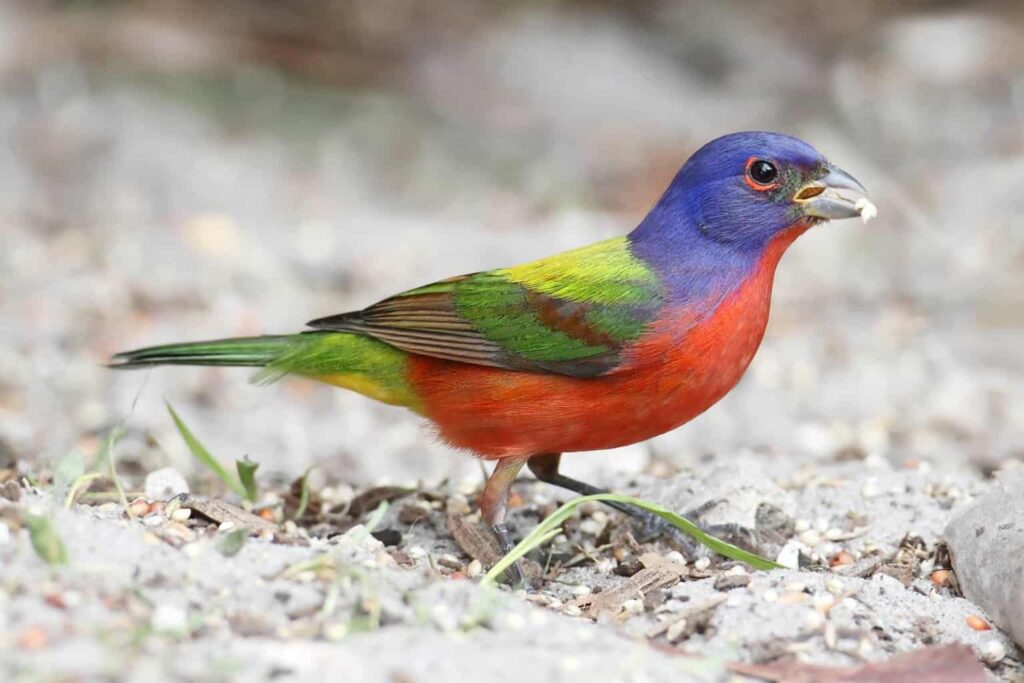The State of Minnesota is located in the upper Midwest, taking up a considerable part of the Great Lakes Region. It shares borders with Canada, Wisconsin, North and South Dakota, and Iowa. Most of this area is covered with woodlands, freshwater bodies, and prairies.
Even though Wisconsin is one of the most metropolitan states and invests heavily in agriculture, it still has plenty of rural wilderness. There are about 80 animal species and 446 species of birds in Minnesota. Bird watchers will have no lack of targets in this state.
In this article, we’ll tell you all about 25 interesting types of bird species, how to identify them, and where you can find them.
Red Birds in Minnesota
Summer Tanager
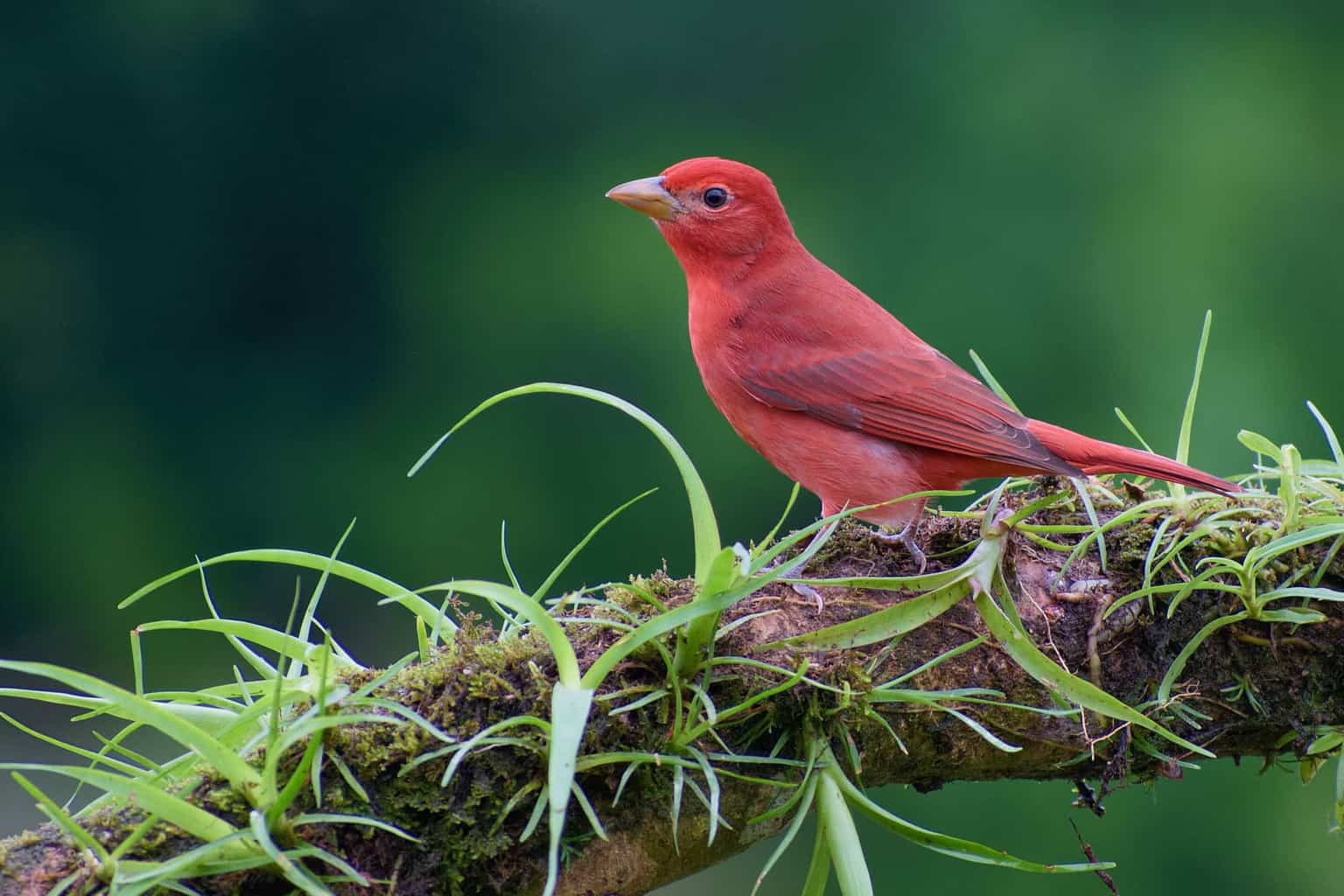
- Scientific Name: Piranga rubra
- Length: 6.7 in
- Weight: 1.1 oz
- Wingspan: 11-12 in
Watching male and female Summer Tanagers would seem like observing two birds from very different species. That’s because the males are bright red and rather plump, while the females are all yellow and lean.
These songbirds are fond of living in the high canopies of dense woodlands. They catch all kinds of insects midair or look for crawlers among the branches. The best way to find Summer Tanagers is by following their distinctive calls and songs.
Northern Cardinal
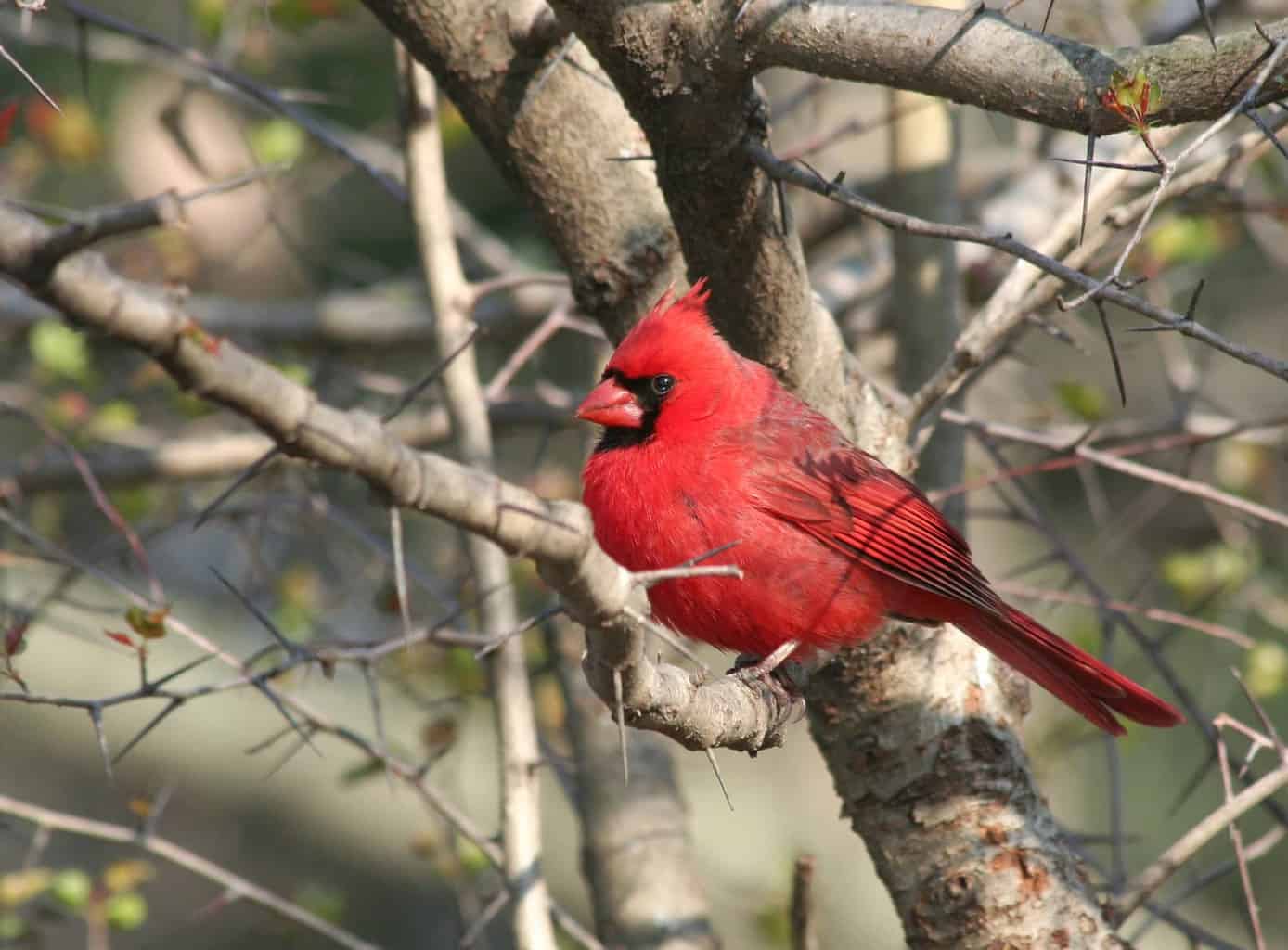
- Scientific Name: Cardinalis cardinalis
- Length: 8.3-9.1 in
- Weight: 1.5-1.7 oz
- Wingspan: 9.8-12.2 in
Prominent crests and thick bills characterize both male and female Northern Cardinals. The males are all red with a black patch surrounding their beaks and going down their throats. The females are adorned with duller colors, as they’re mostly beige with hints of red on their crests and tails, and white spots above their wings.
These beautiful birds are slightly smaller than Robins, and they have tinny calls that they use to assert their presence and socialize. They aren’t by any means timid, and you can see these popular backyard birds around bird feeders filled with black oil sunflower seeds, in backyards, as well as around dense shrubs.
These aggressive birds are very territorial, to the point that they’d attack their reflections in car mirrors or windows. This zealous bravado spikes in the spring breeding season and often fades during the summer season.
Vermilion Flycatcher
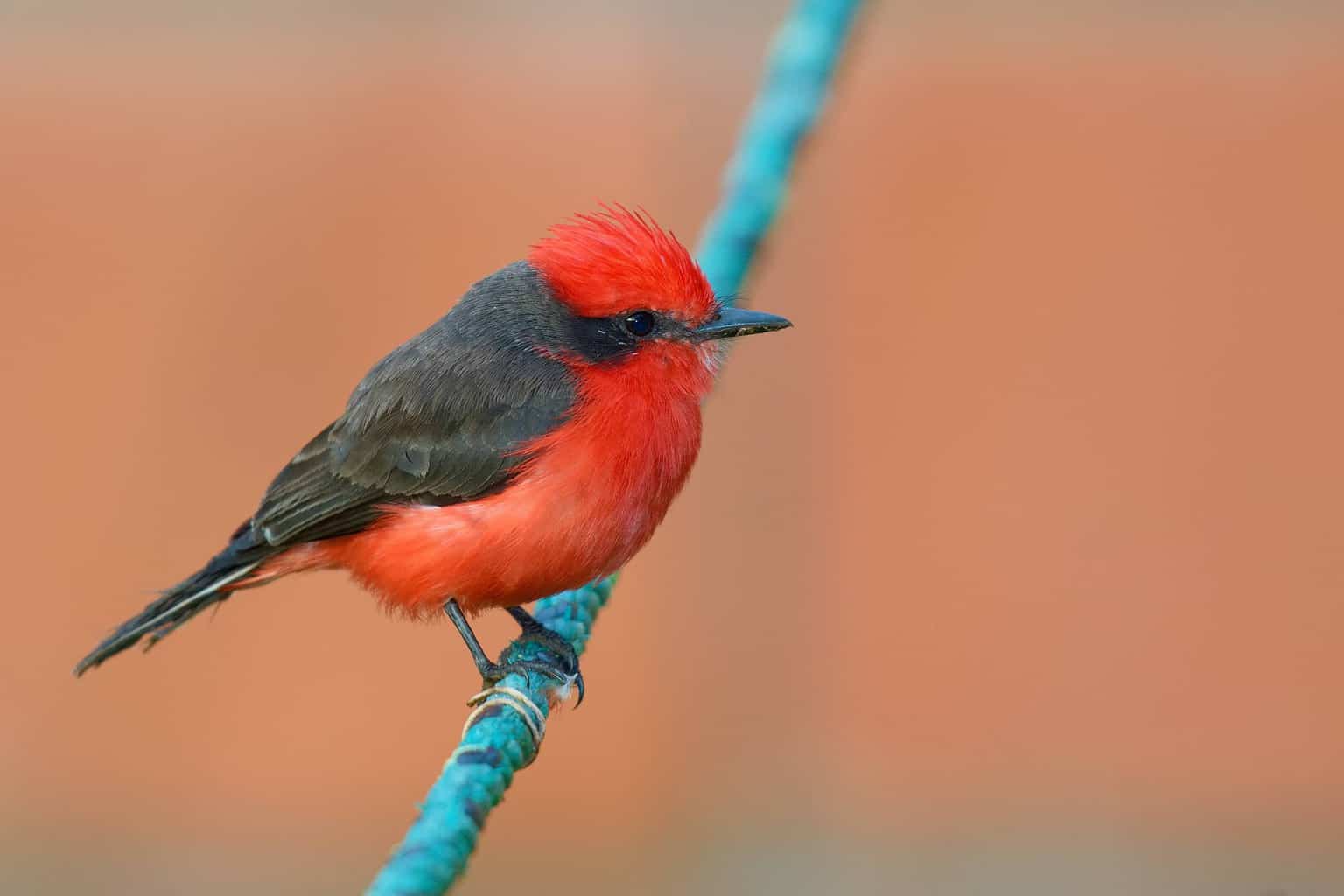
- Scientific Name: Pyrocephalus rubinus
- Length: 4.8-5.4 in
- Weight: 0.4-0.5 oz
- Wingspan: 9.4 to 9.8 in
The Adult Flycatcher bird is among the most highly dimorphic birds; males and females have very few features in common.
The males are relatively lean, and they have predominantly red bodies with black wings and black tails. On the other hand, the females are plump and have basic dull colors of grey, white, and brown.
These birds enjoy hunting and catching insects on the fly. They often stand on fences or low-hanging branches in anticipation of their next meal. And once they fill their little bellies, they’ll break into singing right away.
Rose-Breasted Grosbeak
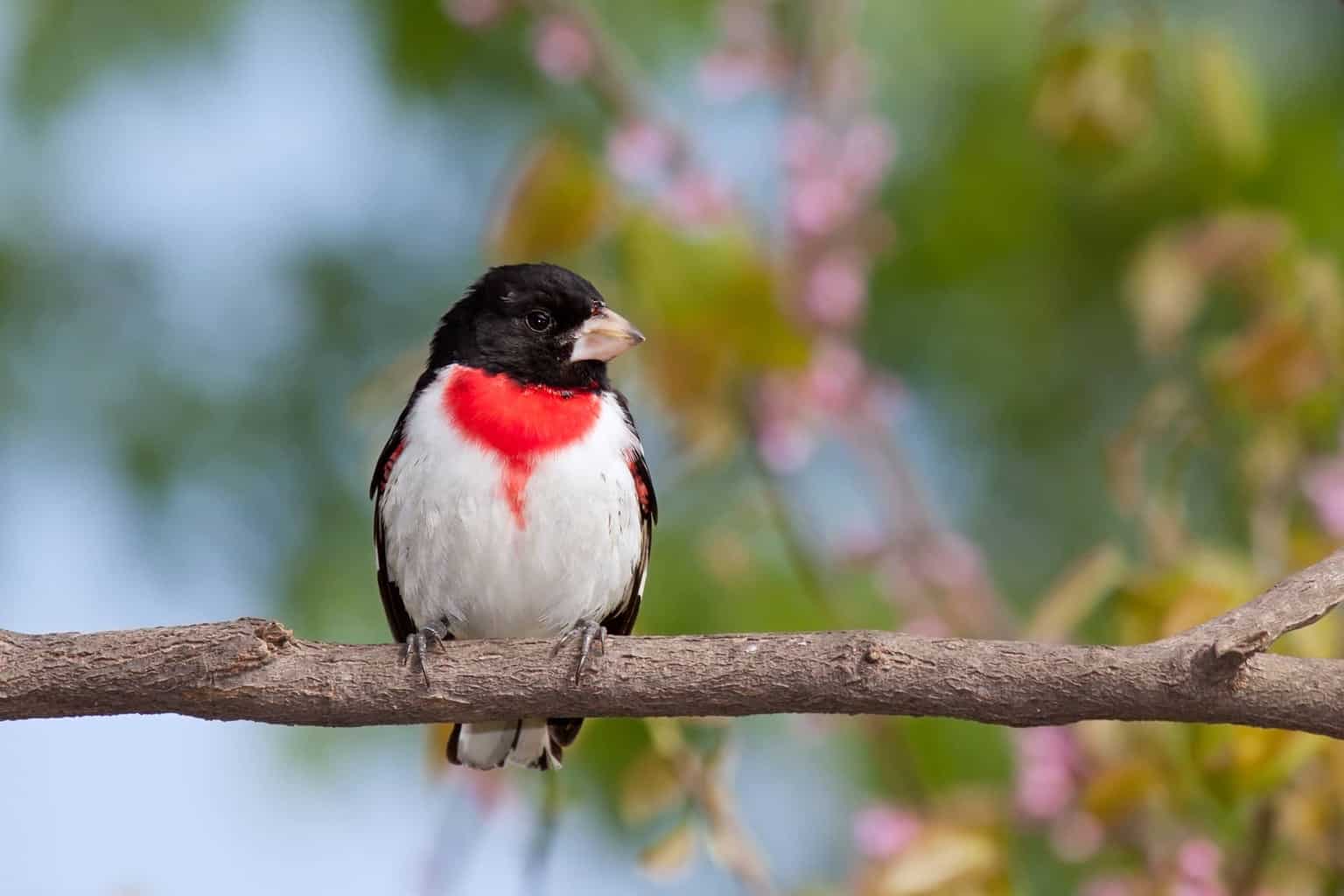
- Scientific Name: Pheucticus ludovicianus
- Length: 7.1-8.3 in
- Weight: 1.4-1.7 oz
- Wingspan: 11.4-13.0 in
It’s the stark contrast between the white, black, and red patches on the Rose-breasted Grosbeak that characterizes this unique bird. That, and the extra-thick bill it has.
This striking palette is exclusive to the males, though, as the females of this species are primarily beige. They have a white marking that looks like a thick eyebrow, and that feature makes them relatively easy to identify.
These birds are insect eaters, and they often catch them in the high canopies of dense forests. A pair of Rose-breasted Grosbeaks take turns in caring for their eggs, and they often share mellow songs as they do so.
Painted Redstart
- Scientific Name: Myioborus pictus
- Length: 5.1-5.9 in
- Weight: 0.3-0.4 oz
- Wingspan: 8.3 in
The Painted Redstarts are among the few warblers that maintain the same coloring in both sexes. They also keep their bright feathers all year round. The juvenile birds are quite different, though, as they’re mostly grey with dull orange color on their upper parts.
You can quickly identify these birds by the bright red patches on their bellies, primarily black plumage color on their bodies, and white highlights on their wings. And if you come closer, there’s also a little white crescent below the eyes.
These birds feed primarily on insects, and they’re relatively stable in their habits. Birdwatchers often follow the Painted Redstarts for their looks as much as their vocalizations.
Blue Birds in Minnesota
Blue-Winged Teal
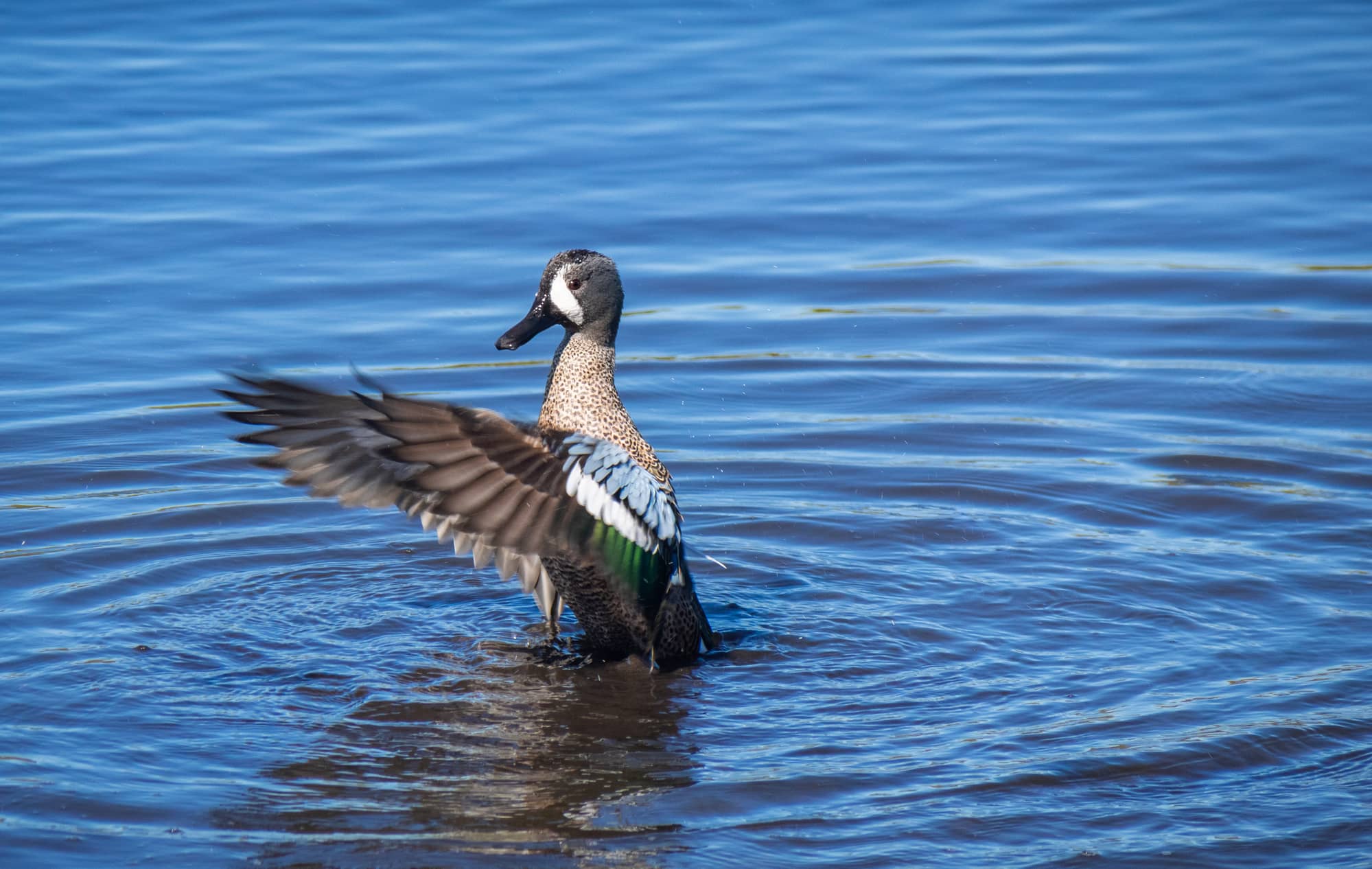
- Scientific Name: Spatula discors
- Length: 14.2-16.1 in
- Weight: 8.1-19.2 oz
- Wingspan: 22.1-24.4 in
The Blue-winged Teal is one of several boldly colored teals, like the cinnamon teal and green-winged teal. It’s a small-sized duck always seen dabbling in the shallows for sustenance.
The blue color is exclusively seen in the male teals, completely covering their heads. You can spot these teals even while they’re swimming. Their full colors are on-show only when they spread their wings and fly.
The females of this species are much harder to identify, as they’re mostly brown birds and resemble the females of several other duck species.
You can find Blue-winged Teals in wetlands, marshes, and shallow lakes. They’re sociable birds that like gatherings and would welcome the company of other bird species as readily as their own kind.
Cerulean Warbler
- Scientific Name: Setophaga cerulea
- Length: 4.3 in
- Weight: 0.3-0.3 oz
- Wingspan: 7.9 in
The adult male Cerulean Warbler is characterized by beautiful plumage of a unique winter-sky rich blue color. It also has distinct white, dark blue, and black bar patterns on its wings and tail. The females are primarily white, with bluish-green feathers on their backs and wings.
These colorful birds are insect-eaters, and they often catch the ones that reach the high canopy branches. Cerulean warblers are migratory birds that spend most of the year in the Eastern forests, then in winter seek warmer weather in the south.
Unfortunately, this bird’s numbers have recently dwindled due to the loss of habitat.
Tricolored Heron

- Scientific Name: Egretta tricolor
- Length: 23.6-27.6 in
- Weight: 14.6 oz
- Wingspan: 37.4 in
Tricolored Herons have an unmistakable appearance, sporting blue, grey, and cinnamon colors. In addition to their long bills, thin legs, and S-shaped necks.
These birds are often seen patrolling the marshes alone or at the fringes of other bird groups. They focus intensely on finding and catching fish, so you’ll always find them walking with intent and purpose in the shallows.
Painted Bunting

- Scientific Name: Passerina ciris
- Length: 4.7-5.1 in
- Weight: 0.5-0.7 oz
- Wingspan: 8.3–9.1 in
Painted Bunting adult males are multi-colored and seem to come right out of an artist’s palette. These birds are quite small, barely the size of a sparrow.
The females and juveniles are different both in coloring and in body shape. They’re more plump and round, and they have a pale olive green coloring overall. Even their bills aren’t as thick as the males.
Painted Buntings are sociable birds, and they’ll readily eat seeds at any backyard feeder. Due to their beautiful appearance, friendly demeanor, and tiny size, these birds are often caged and sold in illegal trade. These dealings affect their populations significantly.
Common Grackle

- Scientific Name: Quiscalus quiscula
- Length: 11.0-13.4 in
- Weight: 2.6-5.0 oz
- Wingspan: 14.2-18.1 in.
Common Grackles come from the Icterids family of songbirds and have stunning graded metallic coloring. It starts deep-blue at their heads, then becomes bluish-green on their necks and olive-green on their backs. Finally, it turns into a deep violet at the fringes of their wings.
The females are less shiny and colorful than the males. Also, they seem to be leaner and lankier. Both sexes are around the size of a Robin, and they have thick, long, curved bills.
This medium-sized bird is fond of eating crops, like corn, but they’ll also eat anything that comes their way. They wouldn’t even refrain from foraging in garbage cans. You can find them in woodlands, marshes, agricultural areas, and even residential areas.
Green Birds in Minnesota
Green-Tailed Towhee
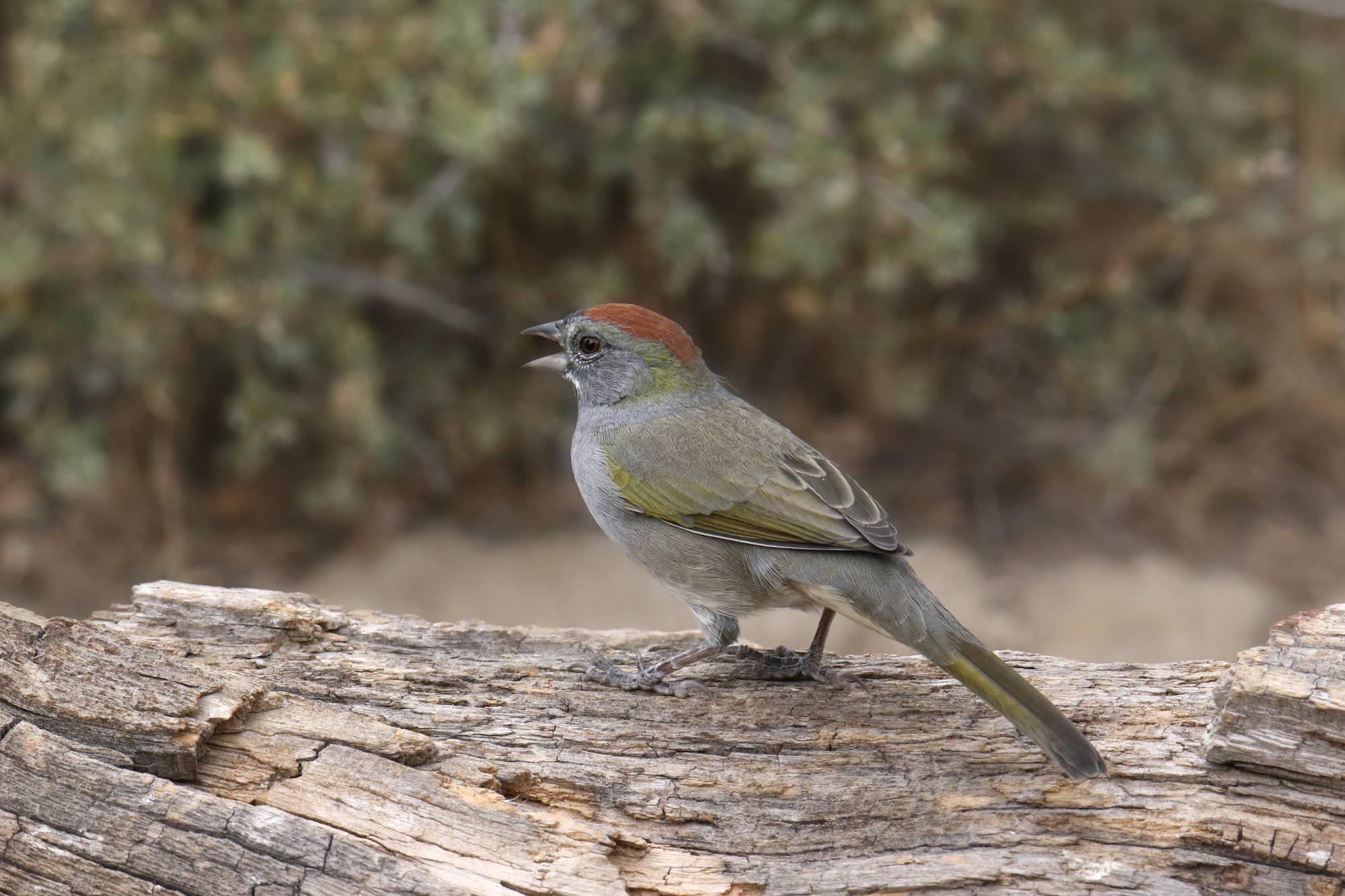
- Scientific Name: Pipilo chlorurus
- Length: 7.25 in
- Weight: 0.8-1.4 oz
- Wingspan: N/A
The Green-tailed Towhee is a plump sparrow with a thick bill. It has a distinctive olive-green color on its back, wings, and tail, in addition to a rust-colored crown.
These birds are ground dwellers, where they are often found in search of food. But they’re a bit timid, so they’ll try to hide in the shrubs.
Green-tailed Towhees are quite protective of their nests, and they have creative ways of defending themselves against predators. They’ll also line them with anything that comes their way, including a few hairs from a porcupine!
Violet-Green Swallow
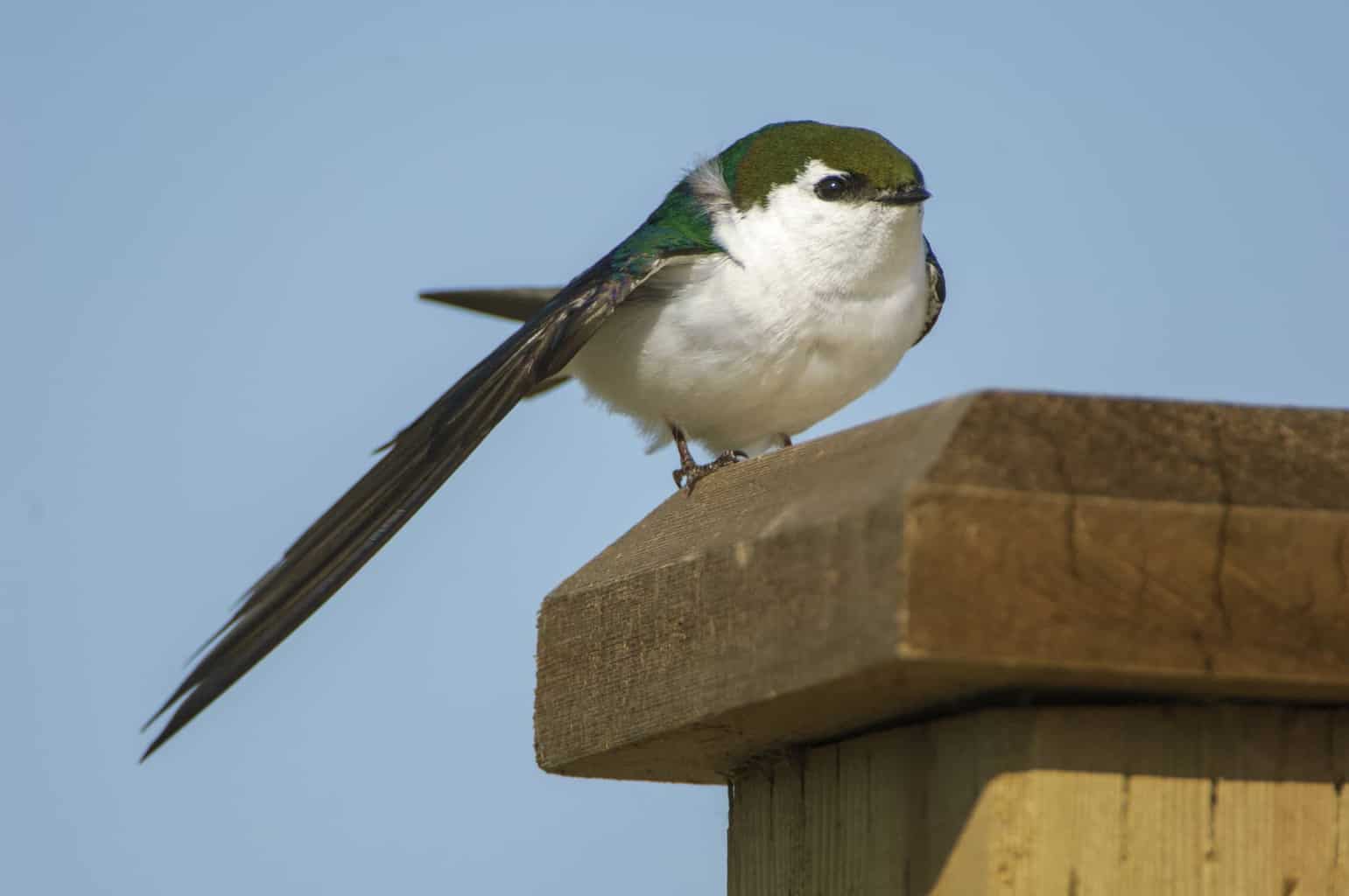
- Scientific Name: Tachycineta thalassina
- Length: 4.7 in
- Weight: 0.5 oz
- Wingspan: 10.6 in
Violet-green Swallows are tiny, gorgeous birds with unique coloring. They have a white belly and throat that contrast sharply with a deep-green back and head. The wings have several color gradations that go from green to violet.
These birds are aerial foragers that feed on flying insects and inhabit open woodlands. They’re summer birds that spend the warm season in the west, and as soon as the winter comes, they fly down to the south.
Northern Shoveler

- Scientific Name: Spatula clypeata
- Length: 17.3-20.1 in
- Weight: 14.1-28.9 oz
- Wingspan: 27.2-33.1 in
The Northern Shoveler is characterized by a green head and neck, white body, and rust-colored sides. It’s also identifiable by a huge bill and yellow eyes.
This description fits the males only though, as the female ducks have inconspicuous neutral colors. The differences extend to shape and size as well, as the females are often smaller and rounder.
Northern Shovelers spend their time in wetlands, flooded fields, lagoons, and coastal marshes. They feed on the small aquatic invertebrates and the occasional seeds they find in the shallows. As for nesting, they usually find a grassy spot at the fringes of water bodies and take residence there.
Hooded Warbler
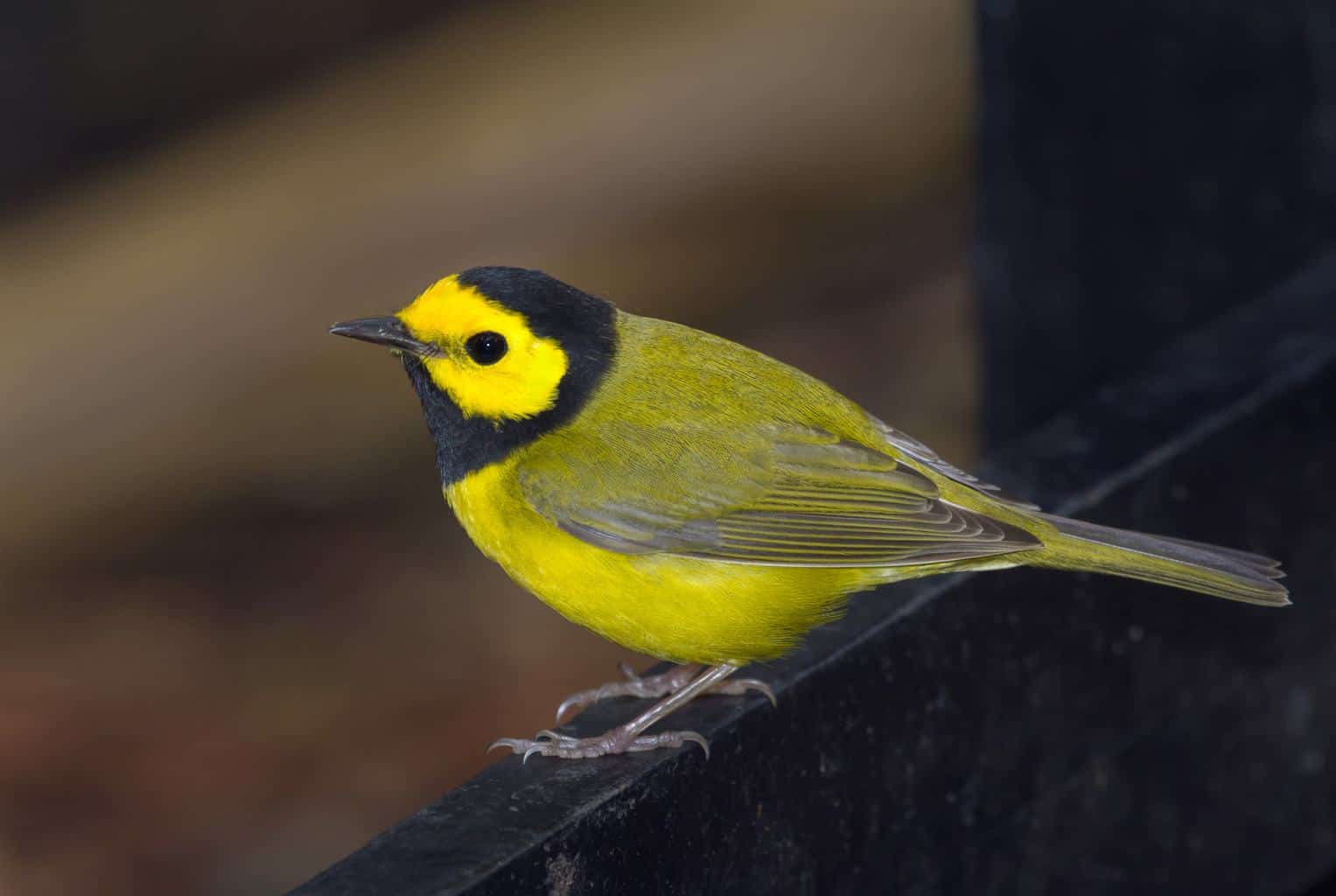
- Scientific Name: Setophaga citrina
- Length: 5.1 in
- Weight: 0.32-0.42 oz
- Wingspan: 6.9 in
The male and female Hooded Warblers share the same general appearance. They’re both olive-green with bright yellow bellies. However, some differentiating characteristics become clear up close. Mainly the black hood and throat on males.
This small-sized bird lives in forests but prefers understory shrubs. They feed mainly on insects, and they aren’t too enthusiastic about visiting backyard feeders.
Hooded warblers are songbirds, and each bird creates a beautiful song that’s discernibly different from its neighbors. This way, it’s easier to distinguish resident birds from any intruders.
Orange Birds in Minnesota
Western Tanager
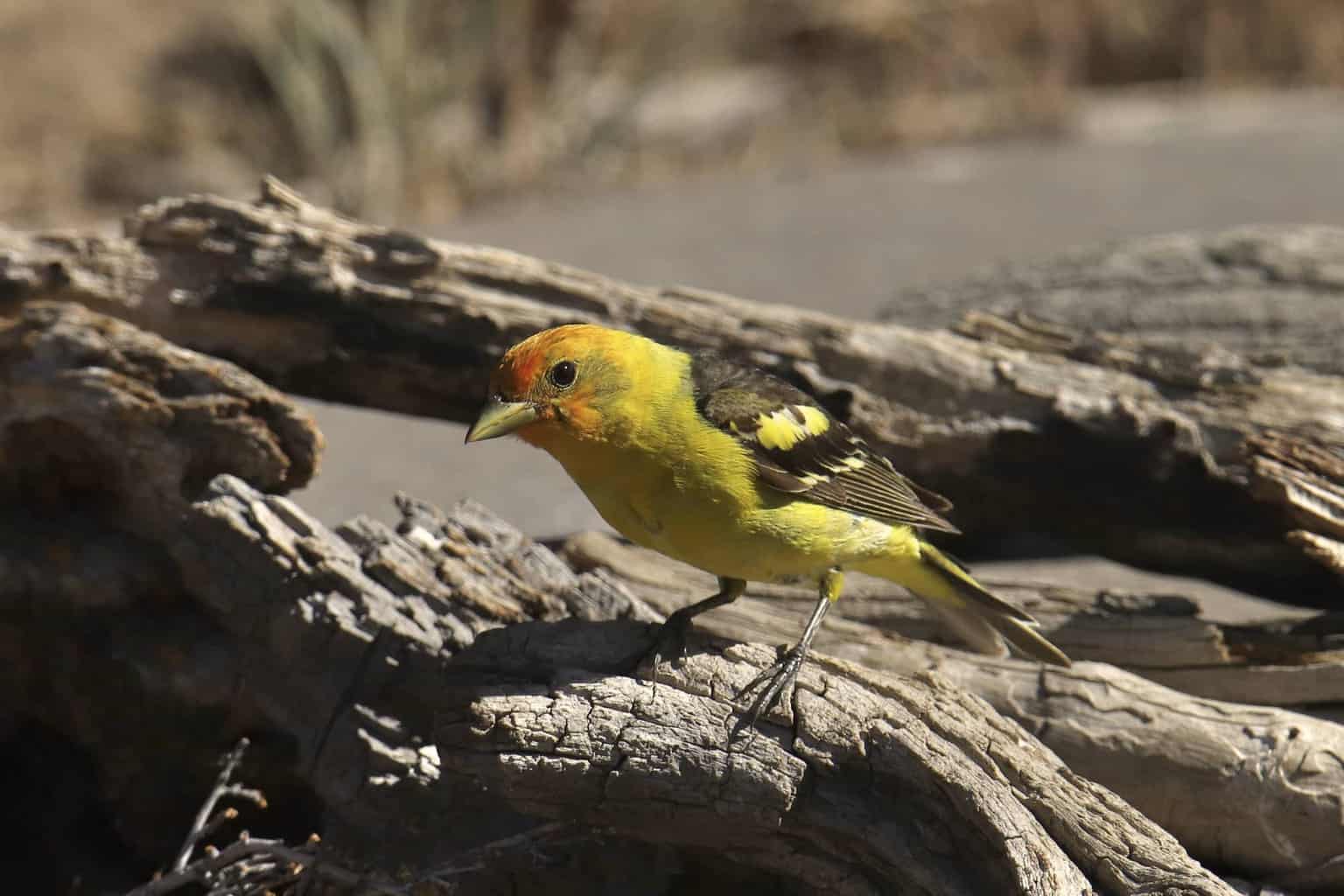
- Scientific Name: Piranga ludoviciana
- Length: 6.3-7.5 in
- Weight: 0.8-1.3 oz
- Wingspan: 11.5 in
Western Tanagers have bright-orange heads, yellow bodies, and black wings. However, the juveniles and females aren’t as flashy as the males.
They typically inhabit forests and glean insects out of low-hanging branches. But they’re also known to warm up to feeders, especially if their favorite foods are there. If you’d like to invite them over, try leaving out some dried fruit or freshly chopped oranges.
Western tanagers have a curious biochemical feature related to their bright colors. While most birds synthesize their pigments from plant sources, the Western Tanagers can only procure theirs from certain insects.
Greater Prairie-Chicken
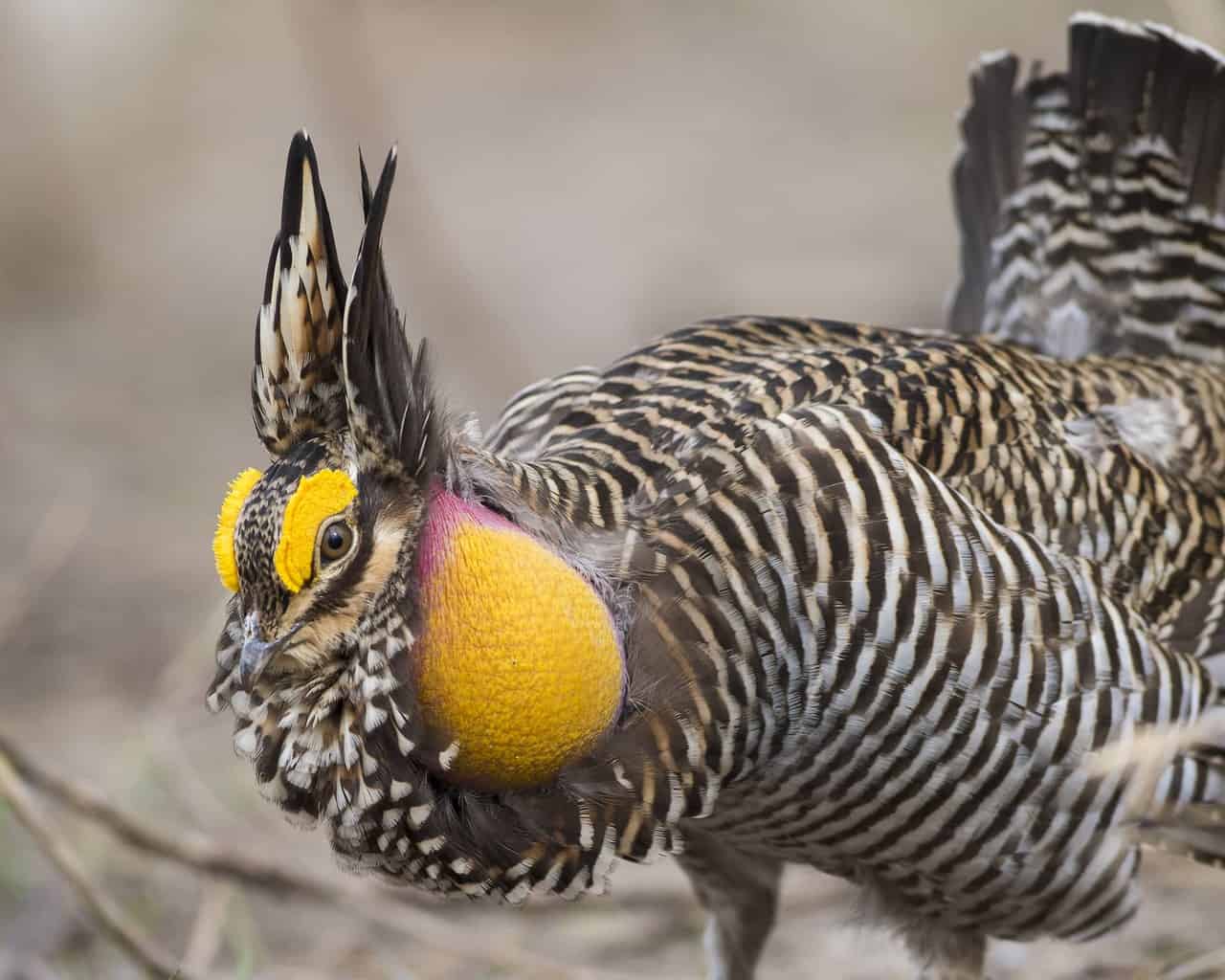
- Scientific Name: Tympanuchus cupido
- Length: 16.9 in
- Weight: 31.9-36.1 oz
- Wingspan: 27.4-28.5 in
The male Greater Prairie-Chicken has unmistakable orange sacs at the sides of its neck, a prominent crown, trimmed tail, and thick legs. It also has an orange patch around its eyes.
The females share white and brown color bar patterns with the males, but nothing more. Additionally, they’re more round, smaller, and look generally different.
You can find these native birds in the tall grass, often walking in groups, and foraging for insects and seeds. They aren’t known for flying high in the skies, but they can cover decent distances in powerful flight. They’re also talented acrobats when it’s time for courtship.
American Robin
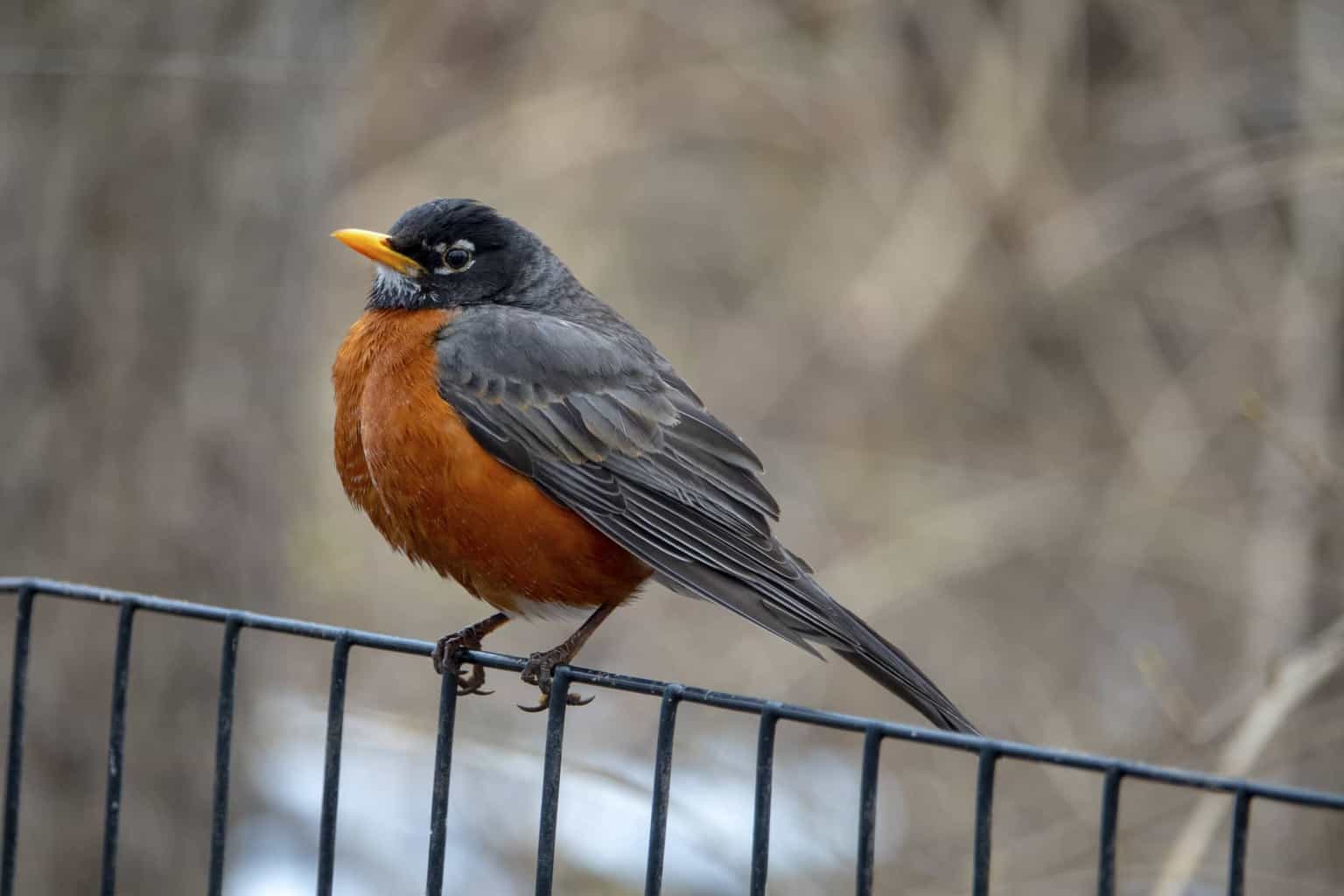
- Scientific Name: Turdus migratorius
- Length: 7.9-11.0 in
- Weight: 2.7-3.0 oz
- Wingspan: 12.2-15.8 in
Adult American Robins have bright orange breasts that contrast sharply with their black bodies. They have plump bodies and a stout build that gives them a generally confident look.
The males and females are almost indiscernible, except for the muted color of the females’ backs, as the females tend to be dark gray with gray tails, as well.
This familiar bird is often welcome among city dwellers as its appearance signals the end of the cold season. They’re also talented songbirds that fill the air with cheerful melodies. The male sings a distinct mating call to attract the female during mating season.
These common backyard birds are fond of berries, and they will gorge themselves with the fruit to the point of intoxication. That’s probably why they augment their diets with insects and earthworms.
Yellow Birds in Minnesota
Yellow-Headed Blackbird

- Scientific Name: Xanthocephalus xanthocephalus
- Length: 8.3-10.2 in
- Weight: 1.6-3.5 oz
- Wingspan: 16.5-17.3 in.
As the name suggests, the adult male Yellow-headed Blackbird sports a flaming yellow head and breast, with the rest of its body covered in coal-black feathers. It has a long cone-shaped bill that connects to its eyes with a black mark.
The females are rather plump, and instead of the deep black coloring, they’re primarily dark grey, with fewer yellow areas.
The preferred habitat for these birds is the prairie wetlands, where they feed on abundant seeds. They also flock around cornfields in large numbers and build their nests above any water bodies they find.
Western Meadowlark

- Scientific Name: Sturnella neglecta
- Length: 6.3-10.2 in
- Weight: 3.1-4.1 oz
- Wingspan: 16.1 in
The adult male Western Meadowlark is Robin-sized, with a strong, plump body and long thin bill. It’s characterized by a bright yellow belly and throat, with yellow highlights reaching their heads. They also have a unique black V-mark on their chests.
The females and juveniles share some of these markings but in a less conspicuous manner.
In addition to their unmistakable appearance, you can also find western meadowlarks by listening to their flute-like melodies. You’ll often find these abundant birds around grasslands, and you can find them at ground feeders, hopping about in pastures, or flocking at the marshes.
Scott’s Oriole

- Scientific Name: Icterus parisorum
- Length: 9.1 in
- Weight: 1.1-1.4 oz
- Wingspan: 12.6 in
The adult male Scott’s Oriole has a lemon-yellow underside and a black back, head, and throat. The females are very different, as they’re primarily yellow with beige wings.
This bird is slightly smaller than a Robin, requiring a bit of an effort to spot. You can find it in woodlands, deserts, or the mountain slopes around them. Furthermore, it has a varied diet that suits these diverse habitats.
Scott’s Orioles will feast on small invertebrates, seasonal fruits, and they won’t say no to a drop of nectar.
American Goldfinch
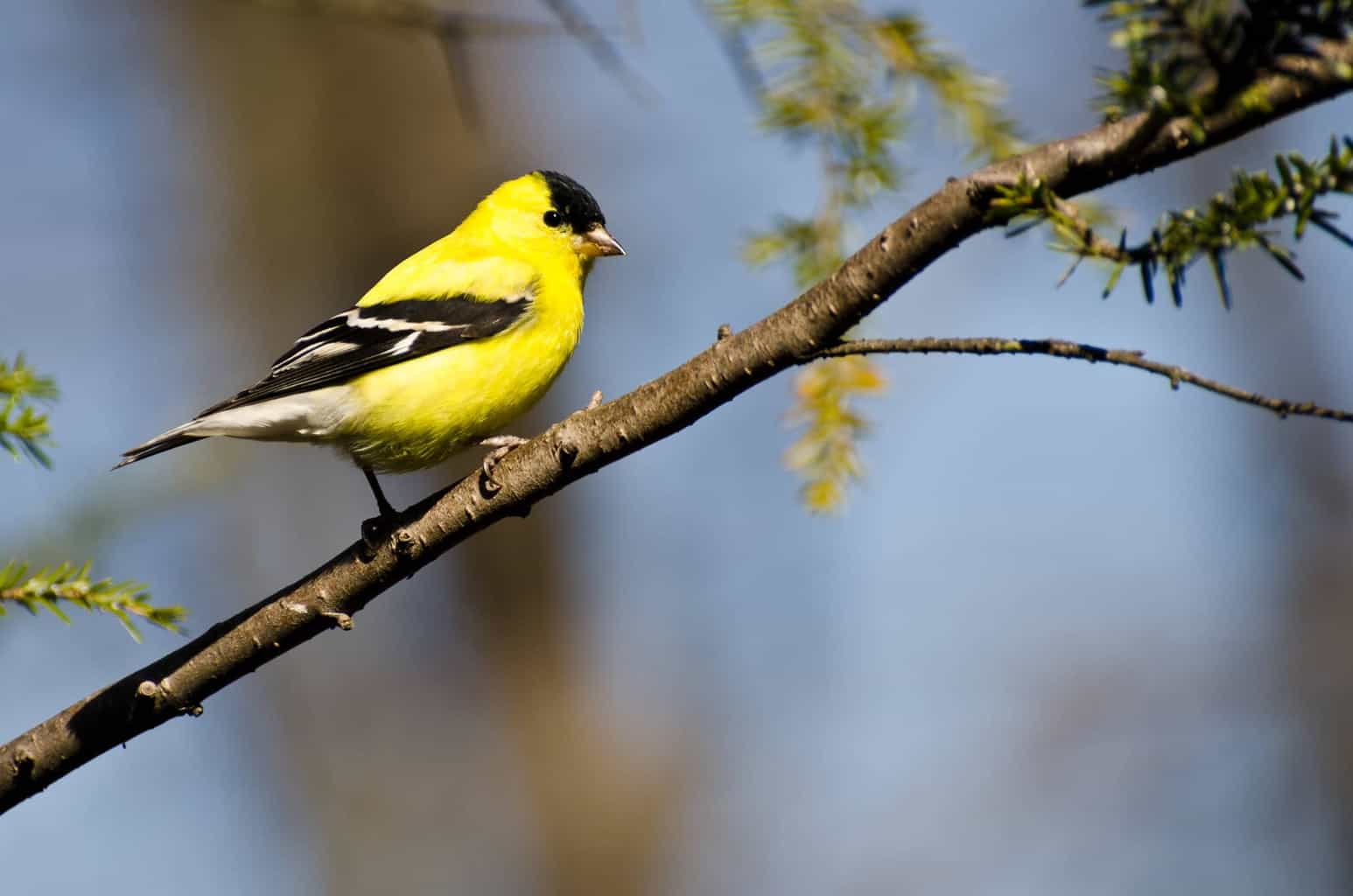
- Scientific Name: Spinus tristis
- Length: 4.3-5.1 in
- Weight: 0.4-0.7 oz
- Wingspan: 7.5-8.7 in
The breeding male American Goldfinch is a small-sized songbird that’s mostly yellow, with black markings on its forehead and white wing bars. In sharp contrast, the non-breeding male is pale brown and hardly gets anyone’s attention. Females are as inconspicuous.
These birds are quite sociable, and they’ll come and visit feeders without any hesitation at all. They’ll be more enthusiastic, though, if they find some thistles or milkweed. They have a strict diet of seeds and rarely eat an insect.
American goldfinches molt twice a year, and that’s why the appearance of their bright yellow feathers marks the spring as well as the fall.
Other Birds To Watch For in Minnesota
Bald Eagle

- Scientific Name: Haliaeetus leucocephalus
- Length: 27.9-37.8 in
- Weight: 105.8-222.2 oz
- Wingspan: 80.3 in
The Bald Eagle is among the largest birds that roam the skies of North America. When it spreads its wings, this raptor is about 80 inches across and 40 inches in length. And if it perches on a branch, it’s easily larger than a goose. Actual bird sightings of this majestic creature are an event you won’t forget.
These birds are fearless hunters, and they often feed on small mammals, fish, waterfowl, and a few other birds. Eagles are also known to steal other birds’ food and sometimes scavenge decaying or dead animals.
Harlequin Duck
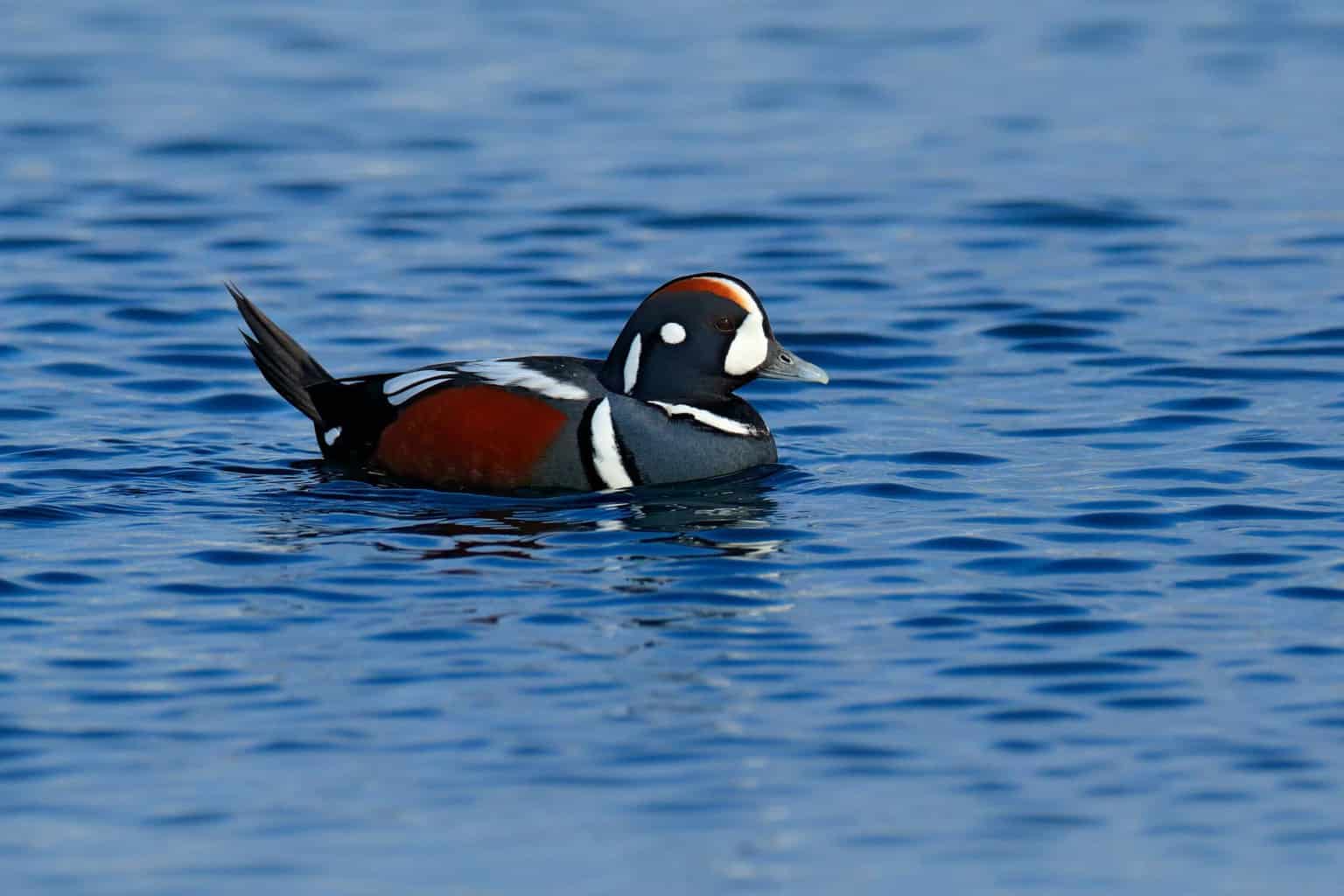
- Scientific Name: Anseriformes
- Length: Male 13.4-18.1 in, Female 13.0-16.5 in
- Weight: Male 7.8-19.0 oz, Female 16.6-23.6 oz
- Wingspan: Male 19.3 in
The Harlequin duck earned its name from its stunning bold patches of color. Only the males flaunt these bright patterns, though, as the females are often grey-beige and inconspicuous.
Harlequins are relatively small ducks with round heads and stout bodies. They typically lead an adventurous life in rough whitewater and around rocky coasts. That’s why it’s not unusual that many of them suffer serious injuries.
Horned Grebe

- Scientific Name: Podiceps auritus
- Length: 12.2-15.0 in
- Weight: 10.6-20.1 oz
- Wingspan: 17.3-18.1 in
The breeding adult Horned Grebe is a picturesque bird. It has a large black head with rich golden feathers on each side. Beady red eyes and a rust-colored body complement the exotic appearance of this bird.
The non-breeding and juvenile birds generally lack that flamboyant color scheme but share the red eyes and pointed bills.
One of the Grebes’ adorable characteristics is how they carry their babies on their backs and protect them with their wings. They swim around with them all day long and might even take a dip with the chicks hanging on to their parents.
King Rail
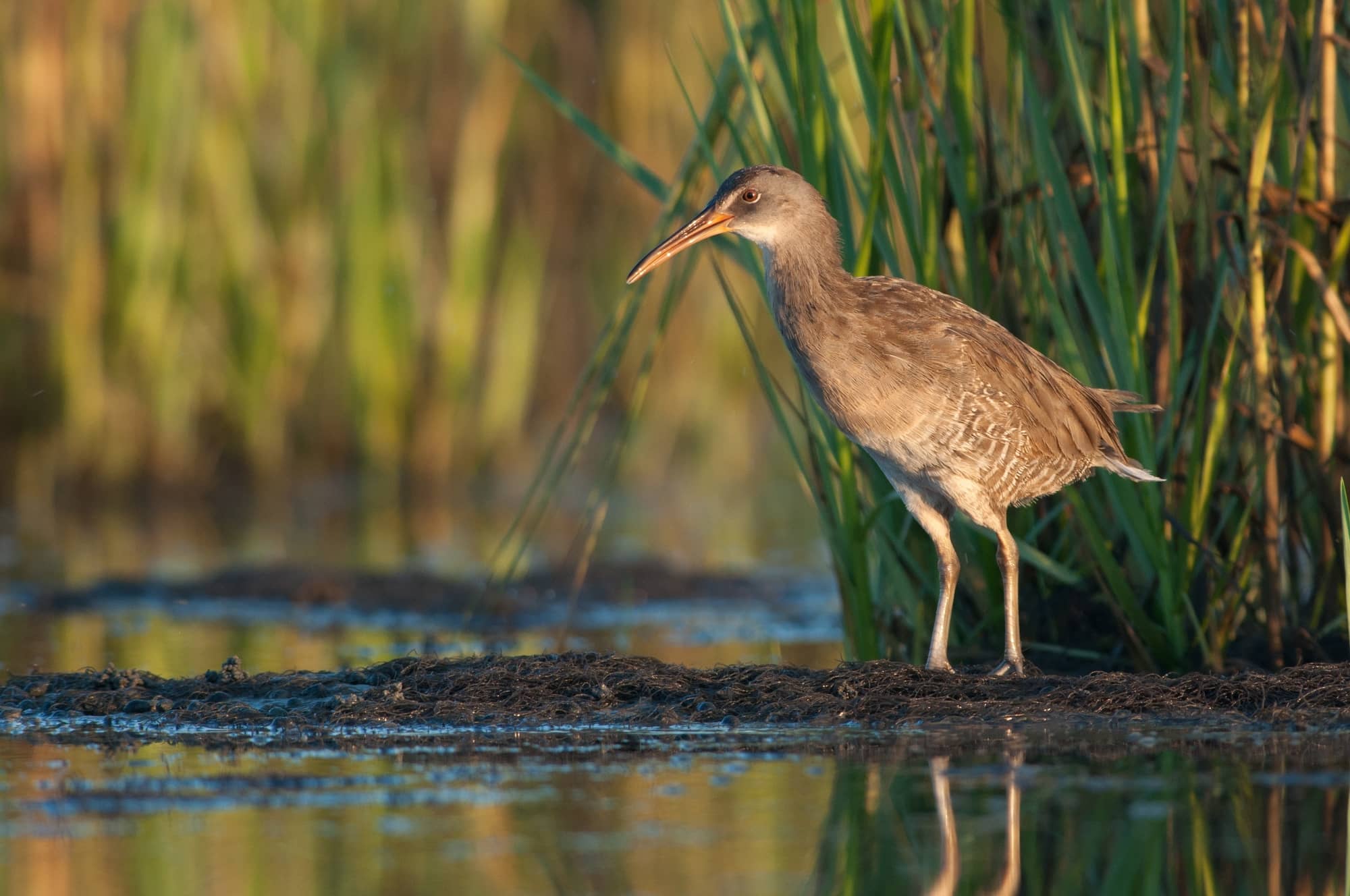
- Scientific Name: Rallus elegans
- Length: 15.0-18.9 in
- Weight: 11.3-15.0 oz
- Wingspan: 19.7-20.5 in
The King Rail is a big bird that resides in freshwater marshes. It’s characterized by its large feet and long probing bill. This anatomy is beneficial to the Rail as it feeds mainly on aquatic invertebrates.
This bird is a loner that doesn’t like to socialize with other creatures and goes out of its way to stay hidden in the vegetation.
The King Rail was once a common bird, but its numbers have dwindled severely over the years due to habitat loss. This bird is currently on the Yellow Watch List, as it’s presently less than 10% of the numbers it reached 50 years ago.
Conclusion
The diverse geography of Minnesota makes it a perfect haven for many animal and bird species. For example, there are about 80 animal species in these woodlands, including the American Black Bear, Bison, and Cougar.
There are also more than 440 bird species that you can see around the large span of wilderness in Minnesota. The previous list has some good information on 25 of the most interesting birds in the area. So, come and see if you can find your favorite bird in this great state.
You can also check out the Woodpeckers and the Hawks in Minnesota while you’re out there.

